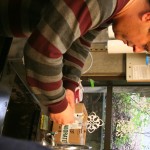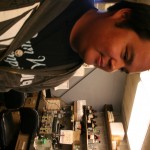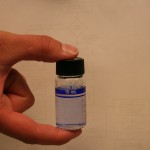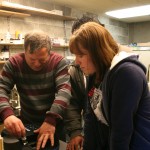Surfactants!
       Surfactants are used in our everyday life, whether we are washing our hands to our hair, cleaning dishes, or cleaning clothes. Surfactants play an important role in our everyday life as humans. Surfactants work by having a hydrophilic head, which loves water and a hydrophobic tail, which hates water. What makes it so useful is the fact that the hydrophobic tail will leech onto all the oil and grease we on household items and on ourselves. Then when each of the tails form a core that encloses an oil droplet, this is called a micelle. This makes both of each end of a surfactant happy. What is useful to humans is causing harm to fish and other inner tidal organism.
           Erica and I, as Beam Reach students in the spring 2009 term, have decided to measure the surfactants that the program releases into the ocean, while on the Gato Verde. With the help of Dr. Russel Barsh we have created a process of measuring each of the samples we have collected on the Gato Verde.
           This is our process for collecting each sample:
1.    Must be 48 hours before we run the test, if it sits to long the sample turns bad.
2.    Rinse syringe three times in sample test water
3.    Attach the filter to the syringe
4.    Filter out the sample and place into a clean container
5.    Place in the refrigerator to keep cool
Once we get back to the Friday Harbor Labs and meet Russel, here is the sample
testing process:
1.    Dilute the sample: 1mL of sample to 99mL of nano pure water.
2.    Scan the blank sample
3.    Add bicarbonate of soda to bring the pH up (used as a buffer)
4.    Add sodium chloride (salt) to bring up the density of the water.
5.    Add 2mL of methylene blue and toluene mix
6.    Mix for 1 minute to allow the formation of micelles
7.    Let it sit for 5 minutes
8.    Shoot the sample
9.    Read the Results
Our results with the four samples we have taken are:
1.    1st grey water sample: 1.7 ppm (2 gallons of water with 2 squirts of joy soap)
2.    2nd grey water sample: 5.5 ppm (4.5 gallons of water with 2.5 squirts joy soap)
3.    Roche Harbor: 0.3 ppm
4.    Mitchell Bay: 1.5 ppm
Most of these numbers are terrible, because 0.5 ppm is lethal to fish and inner
tidal organisms. Some of the effects are disrupting gas exchange across the gill, which clogs up oxygen exchange, and it suffocates the fish. It can also clog pours and disrupt membranes in crustacean causing the membrane to burst. If surfactants are doing damage to fish, how can that affect the SRKW? Our best option right now is to use less, but still find a efficient way to be clean! Remember the saying less is more.
Â
Best Wishes,
PeterÂ
Â
PS: Thank You Dr. Russel Barsh for helping us in the lab and informing us about surfactants and its effects!  Â
Â
Â
Â
Â
Â
Â
Â







 Twitter
Twitter LinkedIn
LinkedIn Facebook
Facebook